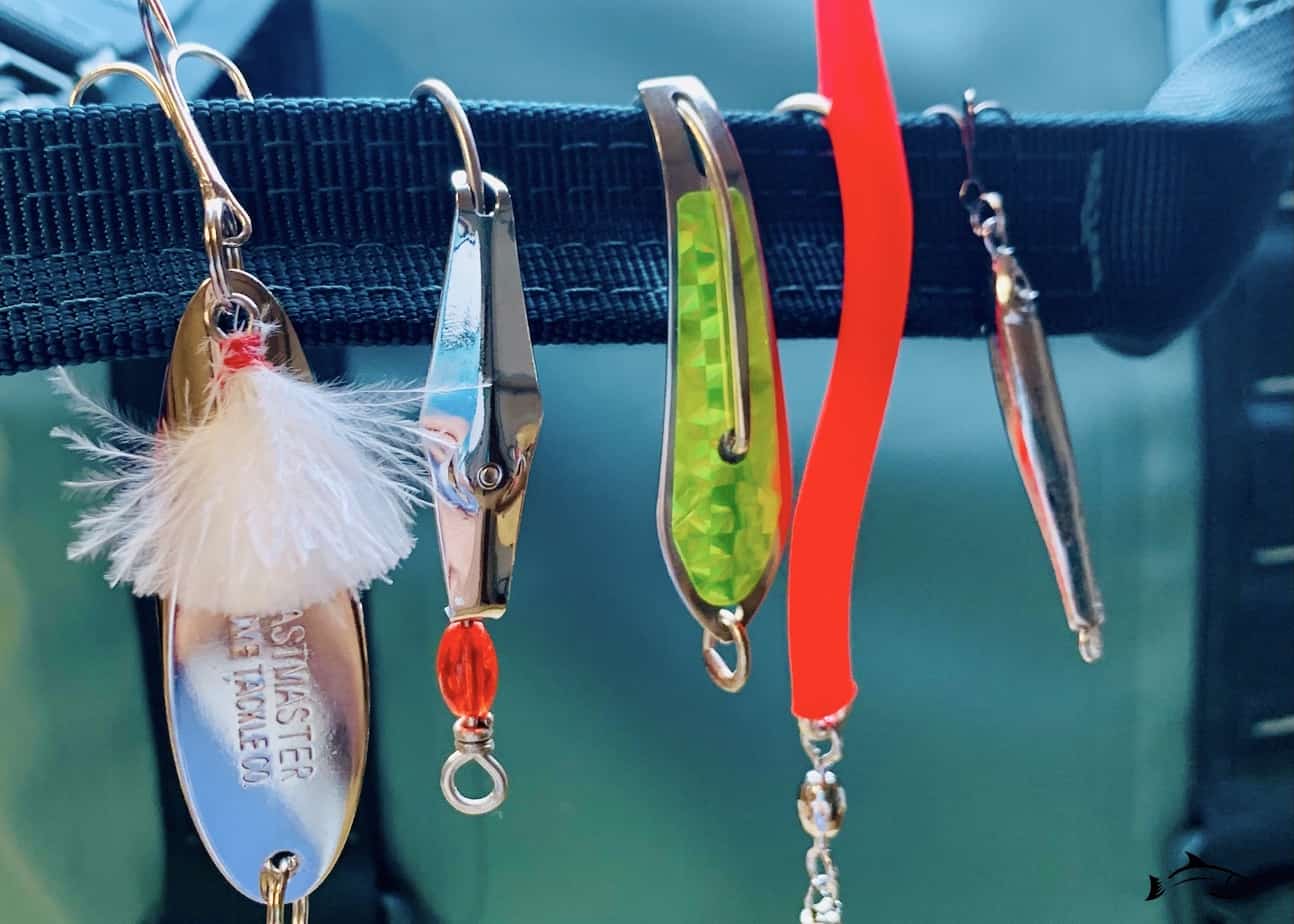Spoon fishing can be some of the most fun fishing you can do. Spoons work well in freshwater or saltwater and you can use them with a variety of techniques such as trolling, casting, and jigging. Some spoons are designed with one technique in mind, and others work for multiple techniques. In freshwater, you can catch bass, perch, stripers, crappie, pike and all kids of fish species. Similarly in saltwater, you can catch wahoo, tuna, Spanish mackerel, kingfish, and the list goes on. The table below lists our MUST HAVE SPOONS, and which technique (trolling, jigging, casting) to use them with.
| Spoon | Troll | Jig | Cast | |
| 1 | Clarkspoon Original | X | X | |
| 2 | Clarkspoon Spoon Squid | X | X | |
| 3 | Drone Spoon | X | ||
| 4 | Diamond Jig | X | X | |
| 5 | Thundermist Stingnose | X | X | |
| 6 | Acme Kastmaster | X | X | X |
| 7 | Luhr Jensen Krocodile | X | X | X |
| 8 | Nichols Lures Magnum | X | ||
| 9 | Weedless spoon | X |
Trolling Spoons
What is a Trolling Spoon?
A trolling spoon is a lightweight spoon made of metal and curved or bent in a way that causes the spoon to wobble when pulled through the water. Trolling spoons are normally a silver metal color with an optional durable sticker to add more flash. They normally come pre-rigged with a strong and replaceable J hook. This allows the angler to replace the hook if rust or corrosion occurs, or even change hook size or style. Due to the lightweight nature of a trolling spoon, they are normally trolled on or near the surface, but can reach depths if used in conjunction with a planar, downrigger, or trolling lead. Some trolling spoons have different wobble patterns to imitate a fleeing, injured, or dying baitfish. Different size spoons are useful to have on hand as each size and style likely has a different range of speeds for optimum presentation.
How to Rig a Trolling Spoon
Spoons can be rigged in several ways when trolling. You can troll with spoons right on the surface if you tie your leader straight to the lure. This is called flatlining and is done often when fishing inshore or nearshore at depths less than 25 feet. Usually flatlining is done in conjunction with trolling at depth for a well-rounded trolling strategy. When surface trolling, you’ll want to use a snap swivel to make it easy on yourself for switching lures and avoiding line twist, but make sure to give yourself a good long leader to keep the snap swivel away from the lure, we recommend between 10 and 25 feet.
For near surface depth, we recommend using trolling sinker such as the Clarkspoon Ball Bearing Trolling Sinker that has a snap-swivel attached. It comes in a range of sizes from 1oz to 4oz. We’d recommend getting a couple of sizes and trying them out. When fish are closer to the surface, try the lighter lead, and when they’re deeper, opt for the heavier lead. You may want to try rigging a rod with a 1oz trolling lead, another with a 2oz trolling lead, and one with a 4 oz trolling lead to find the depth where the fish are biting.
For deeper depths, such as offshore fishing applications, you’ll need to use a planer or downrigger to get the spoon down to depth. A size 1 Clarkspoon Planer with a size 00 Clarkspoon works well for Spanish Macks and Blues. Size 2 planer with a larger drone spoon can get you a Kingfish.
3 Best Saltwater Trolling Spoons
Saltwater Trolling Spoon #1: Clarkspoon
The original Clarkspoon is a long-standing lure. The concave shape causes an erratic wobble that fish find irresistible. Spanish Mackerels love the size 00 (2in) Clarkspoon in the chrome finish right on the surface when we’re trolling about 4-6 mph. For bluefish, we’ll generally slow down the boat a bit, but the same lure would work. If you’re not getting the fish to bite, you can try the gold color or try the spoon squid. You can rig the spoon with a trolling lead or planer to bring it down to a certain depth to target different species. The lure works best when you allow it to wobble as designed, which you can do by rigging the planer, downrigger, or trolling lead far enough away from the lure. The lure wobbles correctly at almost any speed, which makes this classic lure an easy match for the novice or expert angler. This one has a red bead to imitate an injury and a built in swivel to prevent line twist.
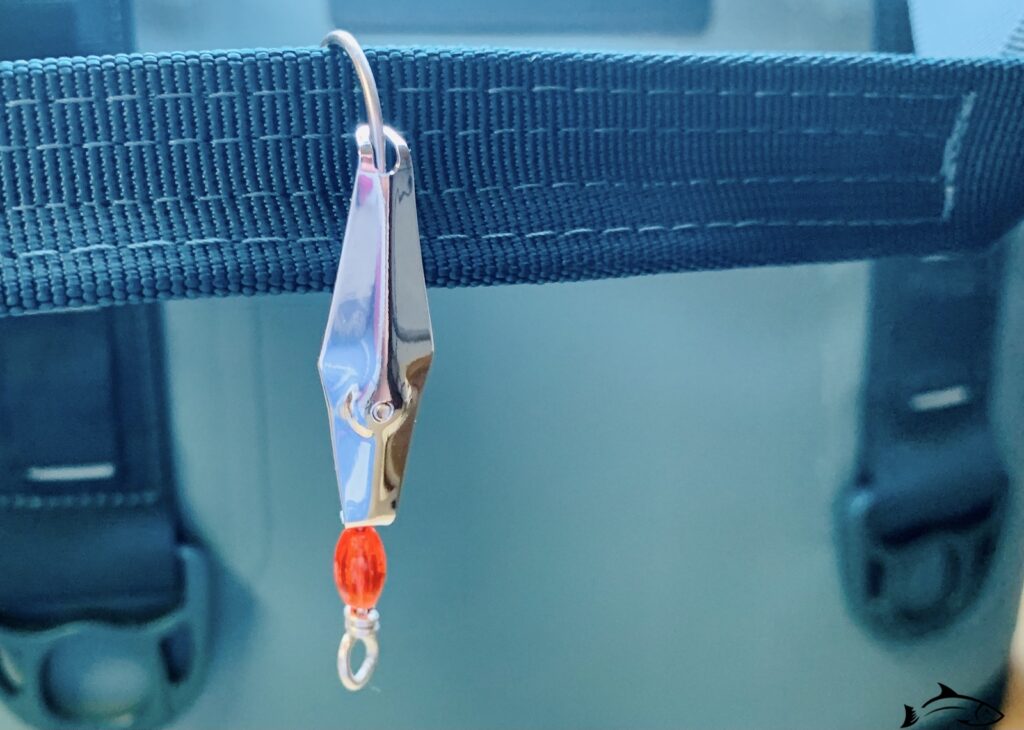
Saltwater Trolling Spoon #2: Clarkspoon Spoon Squid
Now if you want to try a slower troll, we recommend using the Clarkspoon Spoon Squid as this one wobbles more erratically at lower speeds to better mimic an injured baitfish. The ball bearing swivel built into the Clarkspoon Spoon Squid helps give it that extra exaggerated action. We usually carry both the original Clarkspoon and the Clarkspoon Spoon Squid and swap them out until we figure out what’s working that day.
A cigar sinker with a snap swivel works great when paired with a Clarkspoon or Clarkspoon Spoon Squid and at least a 25 foot long 50# fluorocarbon leader line between the sinker and lure. I’ve fished for stripers in the St John’s River with this setup and had a lot of success. The length between the sinker and the lure will help maintain the natural action of the lure. The distance between the sinker, snap swivel, and lure with a fluorocarbon line will make the extra tackle nearly invisible to a skeptical fish. Clarkspoons tend to spin, so the snap-swivel attached to the sinker will further prevent line twist and will also let you swap out lures easily if you need to change sizes or colors.
Saltwater Trolling Spoon #3: L.B. Huntington Original Drone Spoon
Another fantastic trolling spoon is the L.B. Huntington Original Drone Spoon. You must have this one on hand if you do any trolling in saltwater. It has a high quality Mustad O’Shaughnessy hook which is able to be replaced, by buying this replacement, if they dull or rust over time. The material of the drone spoon is superior for corrosion resistance, making it a lure you’ll buy once and keep forever, unless a fish bites through your leader! We recommend getting a color option so you can take advantage of the increased flash with the wobble for catching an aggressive gamefish. If you’re trolling for kingfish or wahoo offshore, try this spoon a few feet behind a tube umbrella rig. It’ll look like a slow and injured baitfish that no wahoo can resist. The only downside is this lure tends to be on the pricey side, but it really will last forever. You may have to change the hooks from time to time, and use a wire leader to prevent sharp teeth from biting it off. Use the 2 ¼ inch size for Spanish mackerel when you’re kayak fishing inshore, and the 5 ½ inch size when trolling offshore for Kingfish.
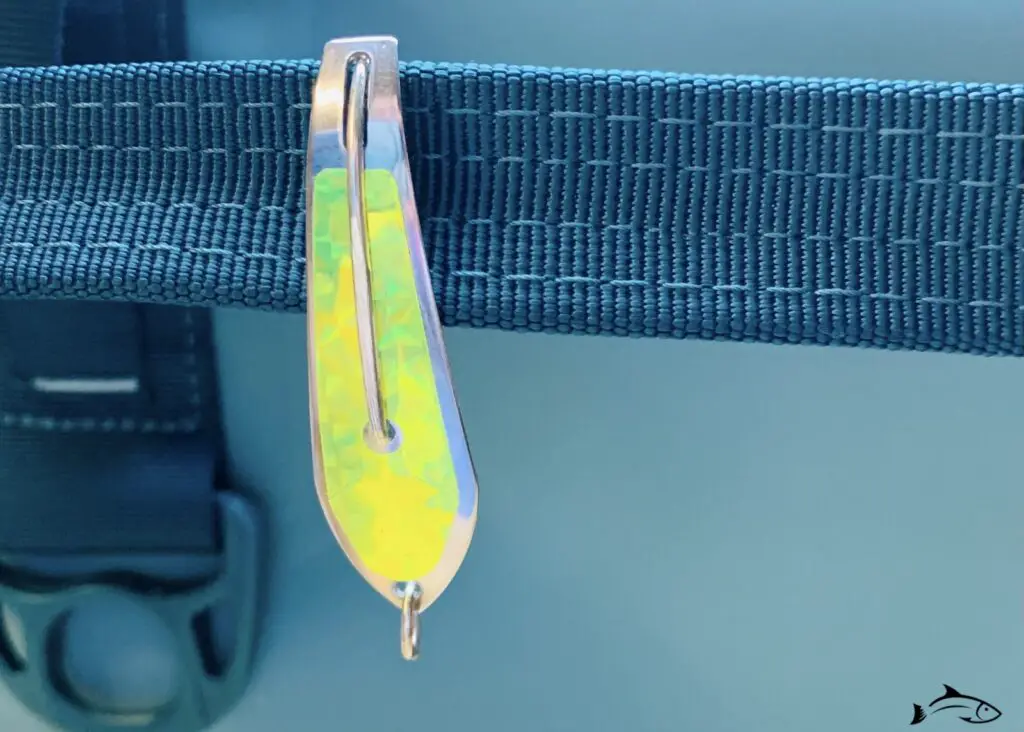
Jigging Spoons
What is a Jigging Spoon?
A jigging spoon is a long and slender, metal bodied lure designed to fall quickly and dart on its way up the water column. Jigging spoons are normally heavy because of the need to fall to the bottom quickly and stay vertical in the midst of a strong current. Jigging spoons work on several saltwater species such as bluefish, snook, and snapper. Some jigging spoons are designed with sharp angles on the body and have a strong darting action. Other jigging spoons are more smooth and have a softer darting action and are best for a jig up and fall retrieve. Jigging spoons can also be casted out to and retrieved with a jerk and pause motion. Whether youre doing vertical jigging or cast and retrieve jigging, jigging spoons work best when you have located fish on a fish finder and work the jig near the school of fish.
How to Work a Jigging Spoon
If you’d like to do vertical jigging over a school of fish near structure, or when ice fishing, Jigging spoons are your best bet. To vertical jig, let line out to drop in the spoon, jig the rod up, let it fall on slack line. Letting it fall on slack line is key as the fluttering will not work properly on a tight line. The lure will dart on its way up and flutter on the fall. Fish will bite on the fall, so set the hook as soon as you feel anything. Normally the bites are soft when vertical jigging, so you’ll need a sensitive rod, usually one with a quick taper and fast tip like this one, to detect the softest bites.
You’ll need to make sure you choose a lure size that’s heavy enough for the depth and water conditions. You don’t necessarily need to be able to reach the bottom, but you’ll need to be able to maintain the depth to which the lure falls without the current sweeping it away. In shallow waters with little to no current, you can opt for a lighter jigging spoon. If the current is moving quickly, go for a slightly bigger size until you find the size that works. You may need to experiment because there’s a sweet spot between a lure big enough to maintain your target depth, but small enough to not spook the fish. No swivel is needed with jigging spoons since the lure doesn’t spin.
You can tie the line directly to the lure, or use a snap for easier lure changes. If using a snap, we recommend using it with a leader to avoid affecting the action of the lure. Use small size spoons when ice fishing for panfish. Larger ones up to 2 ounces are used for striped bass or lake trout. In saltwater, jigging spoons are mostly used in inshore waters.
2 Best Saltwater Jigging Spoons
Saltwater Jigging Spoon #1: Diamond jig
A diamond jig is a classic lure with a long history of success. It is primarily used when vertical fishing for bluefish in saltwater or stripers in freshwater. You can do the traditional motion of dropping it in the water, letting it hit bottom, jigging it up and letting it fall again. You’ll also see lots of anglers imitating a sand eel by letting it drop and hit bottom, and then retrieving really fast up the water column. When doing this particular technique, anglers also tend to tip the diamond jig with a tube to further create the illusion of a sand eel. If you plan on doing this, we’d recommend choosing a diamond rig that has a J hook, instead of a treble hook.
Diamond jigging can be a lot of fun and it's a skill every angler should build up. It really takes practice to be able to notice the soft bite and set the hook properly. As for the size, style and color, I’d start with a classic silver one with a smooth finish. You could also try the hammered metal look for more flash and the gold color for murky days. The size should be around the 4-6 oz option for vertical jigging in saltwater, but you could go heavier if the depth or current demands it. Diamond jigs can also be casted and jigged on the retrieve. If you’re doing this from shore, opt for the smaller sizes like a 1 or 2 oz.
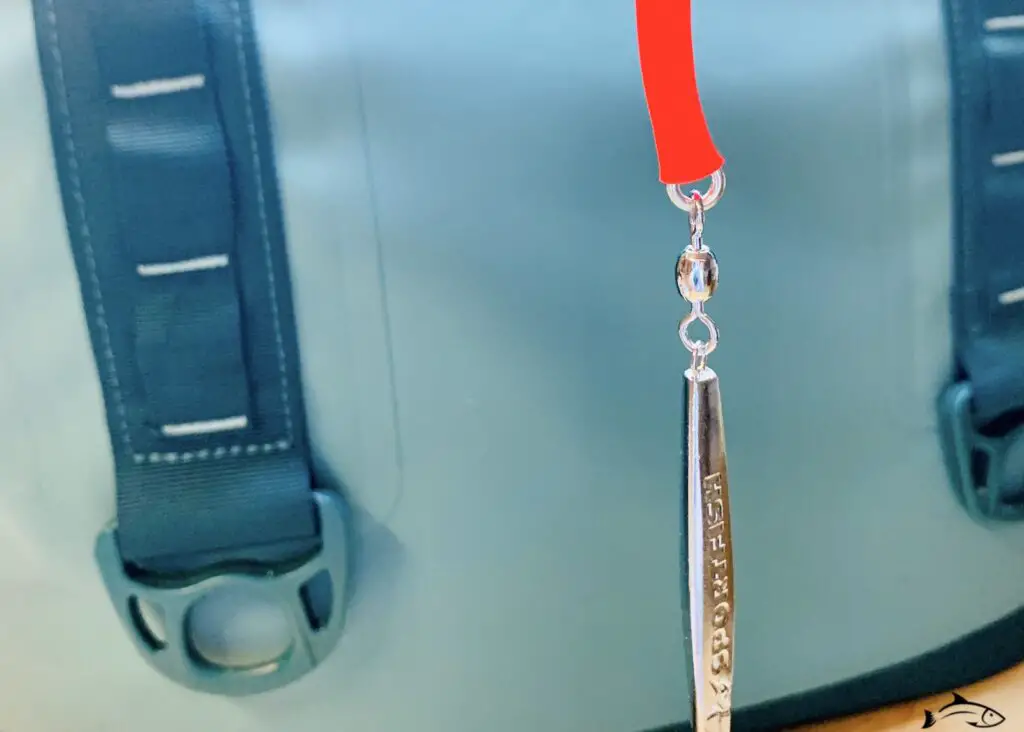
Saltwater Jigging Spoon #2: Thundermist Stingnose Jigging Spoon
The Thundermist Stingnose jigging spoon is versatile in the sense that it works well for vertical jigging and also casting jigging. Its weight makes it easy to cast and it has a great flutter action on the fall. Vertical jigging is great to use if your boat is over structure with a school of fish, or you’re out ice fishing. Casting jigging can be desirable if your boat is anchored but you’re not right over a school, or if you’re fishing from shore. To do this, cast the lure out and do a jig and fall motion, retrieving on the slack line. This method works great in freshwater for perch. If you’d like to avoid the hassle of removing a treble hook, you can swap the hooks on these lures for a J hook. Don’t forget a net to help get the fish in the boat! Use the 3/8 oz size spoon for casting jigging from the beach, and go for a smaller size, like the 1/8 oz when vertical jigging for perch in calm freshwater. The silver color is best for clear days and the gold works best in murky waters.
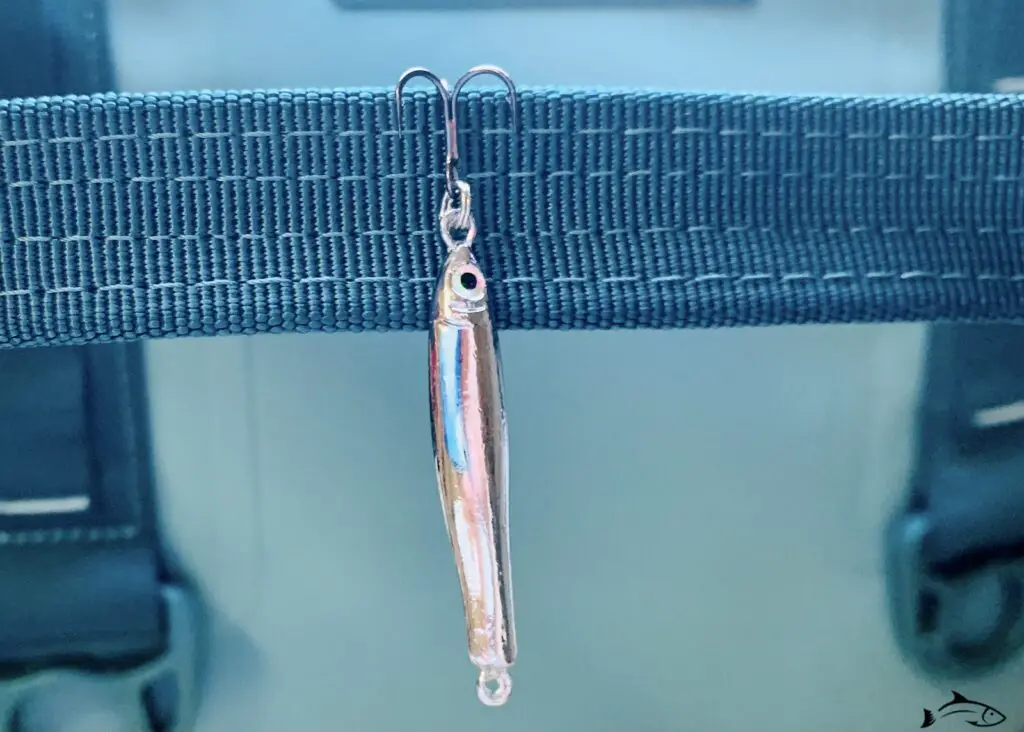
Casting Spoons
Another type of spoons are casting spoons. To use a casting spoon, cast it out and let it fall for a few seconds before retrieving. We’d recommend experimenting between 5-10 seconds of fall time to find the fish. You can also experiment with the retrieval speed. Sometimes a faster motion will get the fish biting and other times a slower retrieve will work. Also try to twitch the rod up during the retrieve. This will keep the lure bouncing and make the lure presentation look more erratic to better imitate an injured baitfish as it flutters on the fall. The great thing about casting spoons is that you can use it in so many applications, whether you’re fishing from the boat in freshwater, fishing from the beach, or inshore or nearshore.
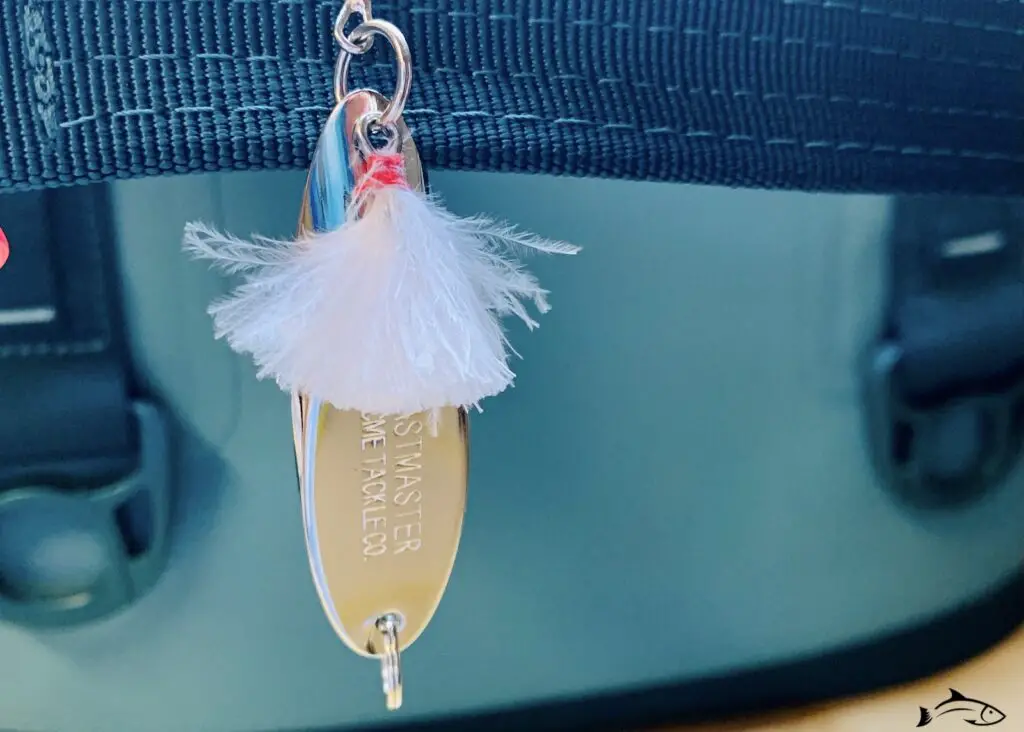
4 Best Saltwater Casting Spoons
Saltwater Casting Spoon #1: Acme Kastmaster
The Acme Kastmaster spoon is a classic casting spoon. It has an impressive history of success for anglers and really is a must have in your tackle box. The Kastmaster has great aerodynamic qualities making it easy to cast long distances you might want from the beach. When surf fishing, I use the ¾ oz size in the silver color. To rig it, I usually use fluorocarbon leader and tie a simple loop knot to the split ring that comes on the lure. I like to use my own custom spinning rod that’s an 8 ft rod, rated for 15-30 lb braid and a 2-3 oz lure. I use my Shimano Stradic XG 5000 series spinning reel with this rod. Checkout my YouTube video below to watch me catch a Spanish mackerel with this setup! If you're in freshwater fishing for trout, you’ll need the smaller size, most likely between 1/8 oz and 1/4oz. Go for a ½ oz size when targeting bass. We also talk about Acme Kastmasters in our article “What is the Best Bait for Surf Fishing?“
Saltwater Casting Spoon #2: Luhr Jensen Krocodile
Another classic casting spoon is the Luhr Jensen Krocodile. Like the Kastmaster, it also has a long history of success. It has a slightly curved body and a thickness that gives it good castability. It comes with a treble hook on it. The castability makes this one a good choice for the surf, but works well for striped bass in freshwater, and redfish inshore, and all kinds of species. Cast this one near some structure or cover in freshwater to target bass. Try the 1oz size in silver for largemouth bass with a 20 lb fluorocarbon leader.
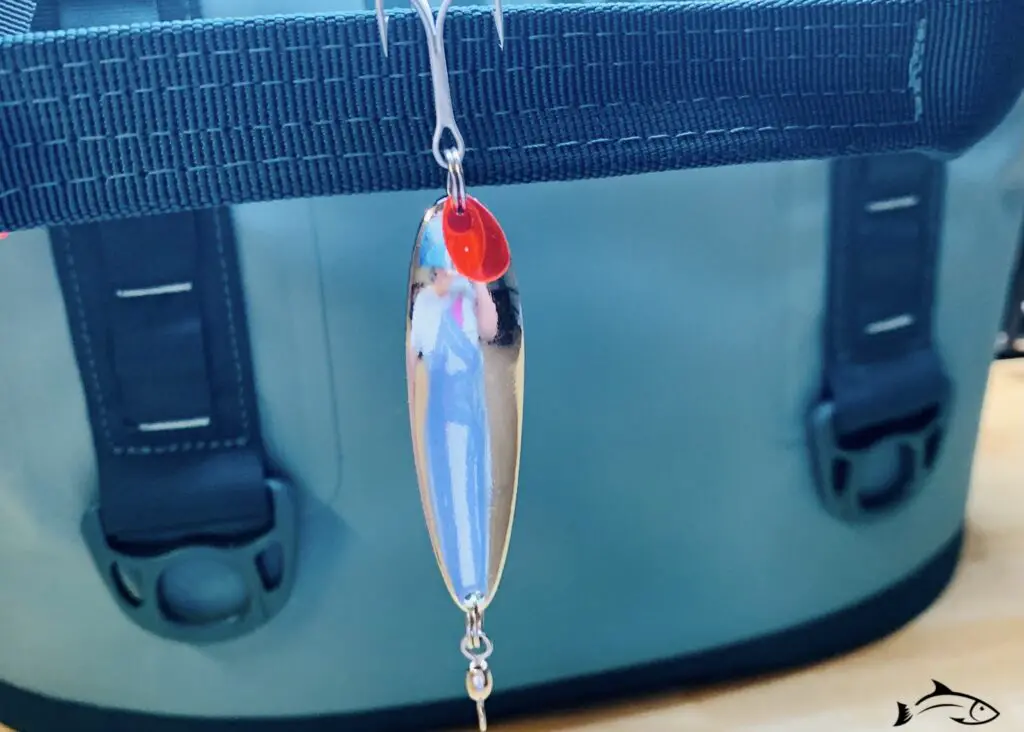
Saltwater Casting Spoon #3: Nichols Lures Lake Fork Flutter Spoon
The Nichols Lures flutter spoons are newer to the market but are also becoming a must have in your tackle box. They have a unique action where you cast it out and it cradles in the water a few times and then sinks with a flutter. They also have a much larger surface area than most other spoons. There are three major sizes, the Mojo is a 2.5” lure, the Lake Fork is 4-5” and the Magnum is 6.5-9”. We like to use the 8” Magnum one most often. Nichols Lures also offers stinger hooks to attach to the top split ring of the lure to increase the odds of catching a fish who strikes your lure from the topside. These spoons come rigged with a nice barrel swivel to decrease line twist when it spins. These spoons have a great action of flutter and flash and you’ve got to try it when targeting largemouth bass. Although it was designed for bass, we’re planning on trying it out inshore in saltwater, hell we might even cast it from the beach.
Saltwater Casting Spoon #4: Berkley Johnson Silver Minnow
The last spoon we recommend having for a well-rounded tackle box is a Berkley Johnson Silver Minnow weedless spoon. It’s another classic because of its tried and true ability to avoid getting stuck in heavy cover while maintaining its ability to hook a fish as long as you make sure the weedguard is properly pulled just above the hook point before you cast it out. We recommend the gold color here as gold outperforms silver in murky waters and heavy cover where you’ll most likely be using a weedless spoon. When we fish for bass with a weedless, we usually put a swimbait trailer on it. When targeting redfish inshore, we skip the trailer completely. Part of the fun with a weedless spoon is its versatility. Try adding whatever soft plastic you have as a trailer and see how it does, or even try a teaser or pork rind. The ½ oz size is a great choice to start with. Read more about weedless spoons in our Surf Fishing with Artificial Lures article.
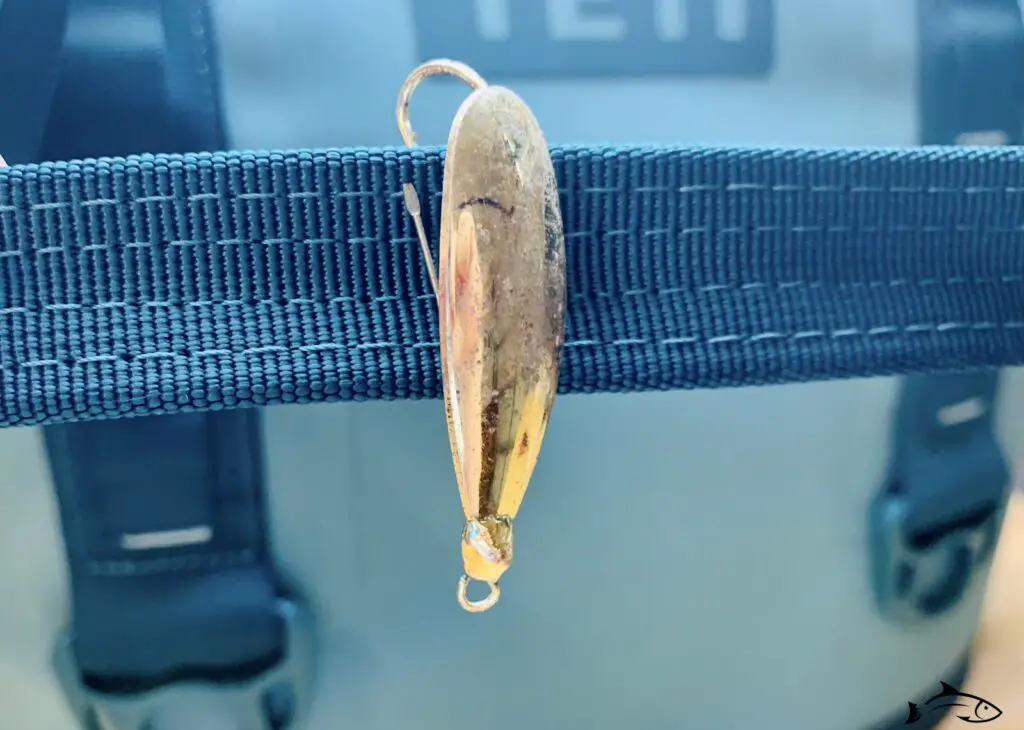
Now that you've finished reading about our favorite spoons for fishing, read even more about lures in our 9 Best Saltwater Topwater Lures (including size and color) article. Tight lines, y'all!
Recent Posts
Fat Cow Jig Strips: The Ultimate Bucktail Jig Upgrade for Surf Fishing
As discussed in my previous article, "Surf Fishing with Bucktail Jigs: Ultimate Guide for Beach Anglers," bucktail jigs are a staple in any surf angler's tackle box, offering a versatile way to catch...
In my previous article, "Surf Fishing with Bucktail Jigs: Ultimate Guide for Beach Anglers," I introduced you to the bucktail jig and discussed how versatile of a lure it is for catching a wide range...

